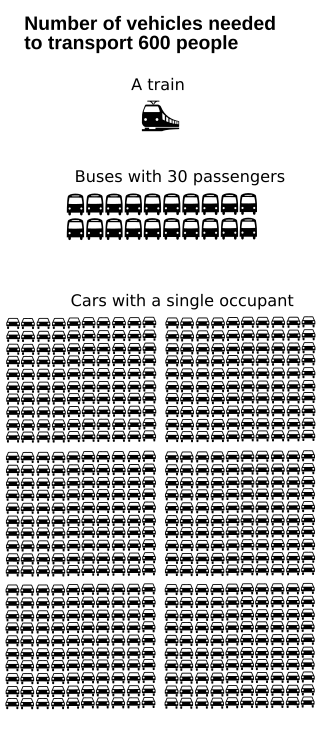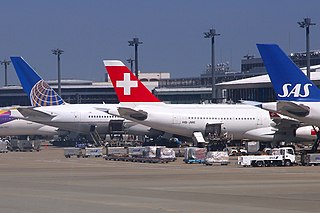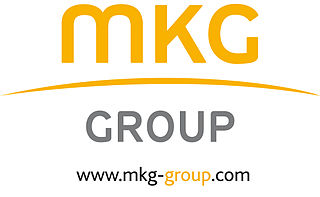Full-time equivalent (FTE), or whole time equivalent (WTE), is a unit of measurement that indicates the workload of an employed person in a way that makes workloads or class loads comparable across various contexts. FTE is often used to measure a worker's or student's involvement in a project, or to track cost reductions in an organization. An FTE of 1.0 is equivalent to a full-time worker or student, while an FTE of 0.5 signals half of a full work or school load.
Enterprise value (EV), total enterprise value (TEV), or firm value (FV) is an economic measure reflecting the market value of a business. It is a sum of claims by all claimants: creditors and shareholders. Enterprise value is one of the fundamental metrics used in business valuation, financial analysis, accounting, portfolio analysis, and risk analysis.
Yield management is a variable pricing strategy, based on understanding, anticipating and influencing consumer behavior in order to maximize revenue or profits from a fixed, time-limited resource. As a specific, inventory-focused branch of revenue management, yield management involves strategic control of inventory to sell the right product to the right customer at the right time for the right price. This process can result in price discrimination, in which customers consuming identical goods or services are charged different prices. Yield management is a large revenue generator for several major industries; Robert Crandall, former Chairman and CEO of American Airlines, gave yield management its name and has called it "the single most important technical development in transportation management since we entered deregulation."

Contribution margin (CM), or dollar contribution per unit, is the selling price per unit minus the variable cost per unit. "Contribution" represents the portion of sales revenue that is not consumed by variable costs and so contributes to the coverage of fixed costs. This concept is one of the key building blocks of break-even analysis.
Price–sales ratio, P/S ratio, or PSR, is a valuation metric for stocks. It is calculated by dividing the company's market capitalization by the revenue in the most recent year; or, equivalently, divide the per-share stock price by the per-share revenue.
Cost per mille (CPM), also called cost per thousand (CPT), is a commonly-used measurement in advertising. It is the cost an advertiser pays for one thousand views or impressions of an advertisement. Radio, television, newspaper, magazine, out-of-home advertising, and online advertising can be purchased on the basis of exposing the ad to one thousand viewers or listeners. It is used in marketing as a benchmarking metric to calculate the relative cost of an advertising campaign or an ad message in a given medium.

In passenger transportation, available seat miles (ASM) or available seat kilometers (ASK) is a measure of passenger carrying capacity. It is equal to the number of seats available multiplied by the number of miles or kilometers traveled by a vehicle.

An apartment hotel or aparthotel is a serviced apartment complex that uses a hotel-style booking system. It is similar to renting an apartment, but with no fixed contracts and occupants can "check out" whenever they wish, subject to the applicable minimum length of stay imposed by the company.

Market share is the percentage of the total revenue or sales in a market that a company's business makes up. For example, if there are 50,000 units sold per year in a given industry, a company whose sales were 5,000 of those units would have a 10 percent share in that market.
Average Daily Rate is a statistical unit that is often used in the lodging industry. The number represents the average rental income per paid occupied room in a given time period. ADR along with the property's occupancy are the foundations for the property's financial performance.
Revenue management is the application of disciplined analytics that predict consumer behaviour at the micro-market levels and optimize product availability, leveraging price elasticity to maximize revenue growth and thereby, profit. The primary aim of revenue management is selling the right product to the right customer at the right time for the right price and with the right pack. The essence of this discipline is in understanding customers' perception of product value and accurately aligning product prices, placement and availability with each customer segment.
A revenue stream is a source of revenue of a company, other organization, or regional or national economy.
GOPPAR is the abbreviation for gross operating profit per available room, a key performance indicator for the hotel industry.

STR, Inc. is a division of CoStar Group that provides market data on the hotel industry worldwide, including supply and demand and market share data. The company has a corporate headquarters in Hendersonville, Tennessee, an international headquarters in London, England and offices in Italy, Dubai, Brazil, Singapore, Tokyo, Jakarta, Sydney, and Beijing.

MKG Group is a consulting and market research firm based in Paris, France. The group operates various divisions within the tourism, hotel and hospitality sector, namely monitoring global trends in supply, demand and pipeline growth, including the worldwide chain hotel brand and chain hotel group rankings, as well as conducting specialised industry research for stakeholders, private investors, developers, hoteliers, government and tourism associations, banking and financial institutions, and hedge funds.
TRevPAR, or total revenue per available room, is a performance metric in the hotel industry. TRevPAR is calculated by dividing the total net revenues of a property by the total available rooms.
Adjusted RevPAR, is a performance metric used in the hospitality industry. It is calculated by dividing the variable net revenues of a property by the total available rooms.
The Buffett indicator is a valuation multiple used to assess how expensive or cheap the aggregate stock market is at a given point in time. It was proposed as a metric by investor Warren Buffett in 2001, who called it "probably the best single measure of where valuations stand at any given moment", and its modern form compares the capitalization of the US Wilshire 5000 index to US GDP. It is widely followed by the financial media as a valuation measure for the US market in both its absolute, and de-trended forms.
Reliability index is an attempt to quantitatively assess the reliability of a system using a single numerical value. The set of reliability indices varies depending on the field of engineering, multiple different indices may be used to characterize a single system. In the simple case of an object that cannot be used or repaired once it fails, a useful index is the mean time to failure representing an expectation of the object's service lifetime. Another cross-disciplinary index is forced outage rate (FOR), a probability that a particular type of a device is out of order. Reliability indices are extensively used in the modern electricity regulation.






